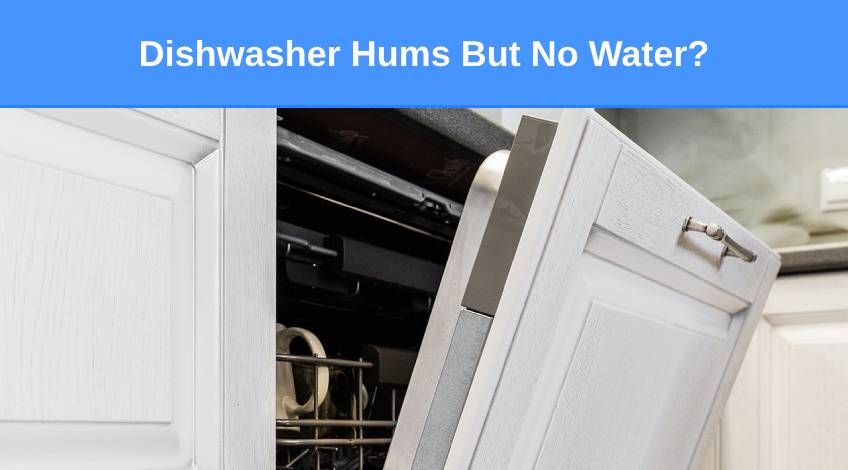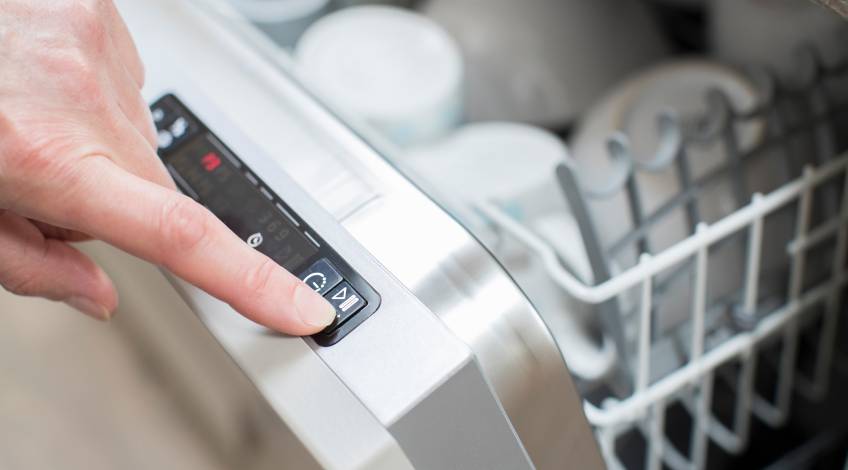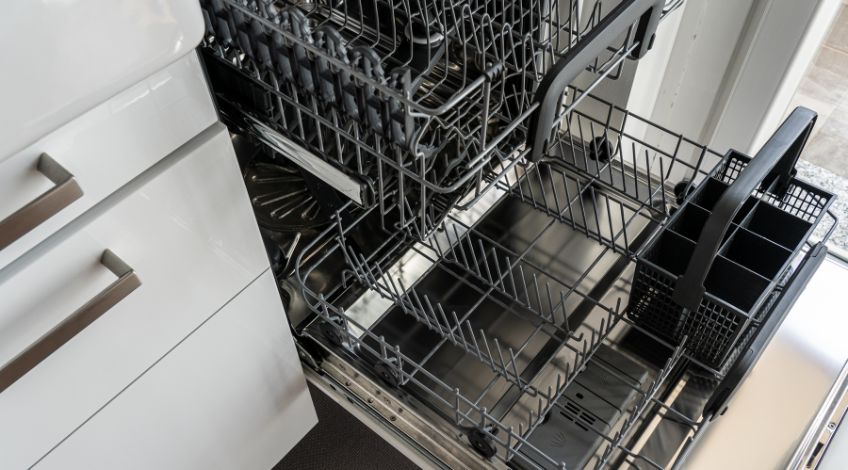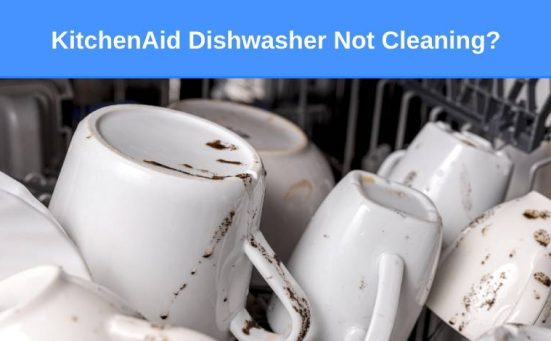
Dishwasher Hums But No Water? Here’s why & what to do
If your dishwasher is making its regular humming noise and isn’t filling with water, or making an unusual humming noise and isn’t filling with water it can be worrying. You’re probably already considering buying a new dishwasher.
But this might not be necessary, because in many cases there’s an easy to fix reason why the dishwasher fails to fill with water. In this article we look at all of the likely reasons why a dishwasher is humming but not filling with water and offer solutions to these issues.
Why Is The Dishwasher Humming But Not Filling With Water?
There are several reasons why the dishwasher could be making an unusual humming noise and failing to fill with water. Which include;
| Probable Cause | Solution |
|---|---|
| Defective Door Switch | Check and replace the door switch if necessary |
| Using Incorrect Detergent | Always use dishwasher specific detergent |
| Blocked water Supply Hose | Check the supply hose and remove any kinks or replace if necessary |
| Low Water Pressure | Contact your water authority |
| Blocked Or Defective Water Inlet Valve | Check, clear or replace the inlet valve as necessary |
| Faulty Float | Check the float and repair or replace as necessary |
| Clogged Spray Arms | Clean the spray arms and remove any blockages |
| Clogged Filter | Clean the filter |
| Blocked Drain Hose | Inspect the drain hose for any kinks and remove any blockages |
| Defective Pump | Inspect & replace pump if necessary |
| Defective Pressure Switch | Inspect, clean or replace pressure switch if necessary |
| Defective Control Board | Contact a technician |
| Wiring Fault | Contact a technician |
Let’s take a look into each now in depth.
Defective Door Switch
Once the dishwasher has been loaded and the door is shut, a message is sent to the control board signifying that the door switch has detected that the door is fully closed and sealed. This is a safety feature to ensure that your kitchen doesn’t get flooded during the normal operation of the appliance.
If the door switch is defective, it could be sending an incorrect message to the control board or not sending any message at all. You can check the functionality of the door switch using a multimeter. However, as replacing the door switch can be tricky, we recommend getting a technician to do this for you.
Using Incorrect Detergent

Dishwasher detergent is designed specifically for use in dishwashers. It produces less soap suds than washing up liquid. If you use washing up liquid in a dishwasher, it is likely to create too much foam.
This can prevent the dishwasher from taking in any water as it detects that it is already full due to the soap suds. In extreme cases, this could lead to flooding!
Blocked Water Supply Hose
The water used to wash and rinse the dishes in your dishwasher all comes through the water supply hose. If this hose is twisted or kinked it could prevent enough water from flowing into your appliance which could cause the humming sound as well as not filling the dishwasher with water.
You can visually check the hose for any kinks or twists and straighten as required. Another more serious problem associated with the water supply hose is a blockage due to limescale build up.
This is likely if you live in an area which is supplied with hard water. Over time the minerals in the water accumulate and eventually cause a blockage large enough to restrict the flow of water into the dishwasher.
You could disconnect the water supply hose and try to clear it using vinegar and a plumber’s snake. However these hoses are relatively inexpensive and easy to fit, so we recommend replacing the old limescale ridden hose with a new one.
Low Water Pressure
If your dishwasher isn’t receiving water at the correct pressure, this could also cause this problem. Dishwashers require a water pressure of between 20 to 120 psi (pounds per square inch). This is normally not a problem as local water authorities are required by law to provide water at an adequate pressure.
You can check this by filling a 1 gallon (4.5 litre) bucket from the cold tap in your kitchen. If it takes 30 seconds or less, the water pressure supplied to your home is adequate. If it takes longer than 30 seconds to fill that bucket, you need to contact your water authority.
Blocked Or Defective Water Inlet Valve

The water’s entry to the dishwasher is controlled via the inlet valve. The control board sends a message to the inlet valve to allow water into the tub once the door switch has reported that it’s safe to do so.
If the inlet valve is blocked with limescale or damaged, it will not allow any water to pass into the appliance. You should also check the filter or screen on the inlet filter for any grit, sand or limescale deposits.
It is possible to clean the screen but this often weakens the structural integrity of the screen. We recommend replacing the screens as they are relatively inexpensive.
You can inspect the valve yourself, but as it involves dismantling panels on your appliance, we recommend getting a technician to inspect and replace the inlet valve if necessary.
Faulty Float
Inside the dishwasher’s tub typically on the bottom somewhere, there will be a float. This is another safety feature designed to prevent the dishwasher from overfilling with water and flooding your home.
Over time, the float can become stuck in the water full position which will prevent any water from flowing into the appliance. You can check the float by hand to see if it moves up and down properly.
If it is faulty, it will need to be replaced which is a job we recommend getting an expert to do for you.
Clogged Spray Arms
All of the water that enters the dishwasher is sprayed via the spray arms. If these become clogged it can prevent water from being evenly distributed around the tub.
To check the spray arms for any blockages from grease, fat, food debris or limescale build up, you will need to remove them from the dishwasher. Once removed they should be washed in warm water to remove any foreign bodies.
Inspect the nozzles for any blockages, in most cases, it will be limescale from the hard water supply that’s the problem. To remove any limescale from the nozzles you will need a toothpick.
You should carefully prise the blockage from the nozzle taking care to remove the blockage and not force it in any further. Once all of the debris has been cleared, reinstall the spray arms and run a short cycle to see if that has cleared the problem.
Clogged Filter

If the filter on your dishwasher is clogged it could be the reason the appliance is making a humming sound and not filling with water. The filter is designed to trap food particles, broken crockery and other debris which is the result of washing the dishes.
The filter prevents these particles from returning onto the now clean dishes. A blocked or clogged filter inhibits the drainage function of the dishwasher.
This can be enough to prevent the appliance from filling with water. To solve this you will need to remove the filter which is located on the bottom of the tub. There will typically be an arrow indicating which way to unscrew the filter which will then lift out of its housing.
Clean the filter under running water and use a toothbrush to remove any stubborn stains. For any really stubborn grease or limescale, you can soak the filter in a 50/50 solution of white vinegar and warm water for around 30 minutes or so.
Blocked Drain Hose
If the filter is clogged, it’s logical to expect the drain hose to be blocked as well. The first thing to do is check that there are no twists or kinks in the drain hose.
You can then disconnect one end of the hose and run a plumber’s snake through it to ensure there are no blockages.
Defective Pump
If the dishwasher hasn’t been used for more than a week, it’s possible that the pump seals have dried out. If this is the case you can solve it by dissolving 3 to 4 ounces (85 to 113 grams) of citric acid into 2 pints (1.14 litres) of hot water.
Pour this solution into the sump area of the dishwasher and allow it to sit for 15 to 30 minutes. You can use 1 cup of white vinegar instead of citric acid if you prefer, but it’s not as effective.
If the pump proves to be defective, it will need to be replaced which is another task best left to an expert.
Defective Pressure Switch
A defective pressure switch could cause the dishwasher to hum and not fill with water. The pressure switch detects the water level in the appliance and controls the water flow accordingly.
If the pressure switch develops a fault, or becomes stuck it could prevent the appliance from filling with water. You will need to get the pressure switch checked and if necessary replaced to solve this problem.
Defective Control Board

The control board is central to all functions on the dishwasher. If the control board becomes defective or develops a fault, it could cause the dishwasher to not fill with water and make a humming sound.
Your first action should be to check the LED display for any error codes. Then you should try to reset the dishwasher by disconnecting it from the power supply for at least 15 to 30 minutes.
If none of the above works, it’s time to contact a technician.
Wiring Fault
All of the components in your dishwasher are connected via a myriad of wiring and connectors. Any one of which could develop a fault and cause the appliance to make a humming sound and not fill with water.
As inspecting the wiring and connectors involves dismantling the dishwasher, we recommend getting a technician to do this for you.
How To Prevent Dishwasher Problems

Once you have solved the issue of the dishwasher making strange humming noises and not filling up with water, you will need to keep it running at its best. To do this you should do the following;
- Always Rinse Dishes Before Stacking Them In The Dishwasher
By rinsing the dishes, you ensure the filter has less debris to deal with which will prevent it from becoming blocked. - Only Use Detergent Designed Specifically For
Dishwashers
Dishwasher detergent is specially formulated to work in dishwashers without creating too many suds. - Clean The Filter At Least Once Per Month
You should make cleaning the filter a regular part of your dishwasher maintenance to prevent any blockages. - Run A Hot Service Wash At Least Once A Month
To ensure your dishwasher works at its best, you should run a hot service wash once every month. This will clear any build ups of detergent, food, grease etc. - Use The Dishwasher At Least Once Every 7 Days
To prevent the pump seals from drying out, the dishwasher should be used at least once per week.
How To Run A Service Wash
To ensure the smooth running of your dishwasher, you should run a hot service wash once every month. This entails; using a commercial dishwasher cleaner or a bowl of white vinegar.
Place the dishwasher cleaner as per the instructions on the packet, or place the white vinegar in a bowl on the top rack of the empty dishwasher. Then select the hottest cycle on the dishwasher and press start.
Once the cycle has completed, clean the filter, clean the door seal (gasket) and wipe down the exterior of the appliance.
SEE ALSO: Dishwasher Not Drying Dishes? (here’s why & what to do)
Frequently Asked Questions
If your dishwasher is making a humming sound and not cleaning the dishes it could be, a faulty pump, a faulty water inlet valve, a defective door switch, low water pressure, blocked water supply hose, defective float, clogged spray arms, clogged filter, blocked drain hose, a defective pressure switch, faulty wiring or a defective control board.
It is quite normal for a dishwasher to make a humming noise when in operation. The sound is made by the drain pump when it is running.
To unclog the spray arms on your dishwasher you will need to remove them and wash them in warm soapy water. Then using a toothpick carefully prise any limescale from the nozzles. Take care to prise the blockage out and not force it further into the nozzles. If the blockage is difficult to remove, try soaking the nozzles in white vinegar for at least 30 minutes to soften the limescale deposits.




